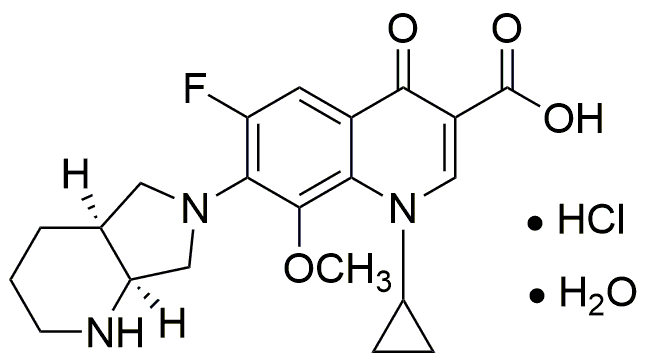Moxifloxacin hydrochloride monohydrate is widely utilized in research focused on:
- Antibiotic Development: This compound is a key player in developing new antibiotics, particularly for treating respiratory infections, showcasing its effectiveness against various bacterial strains.
- Clinical Research: It is extensively used in clinical trials to evaluate its efficacy and safety for patients with complicated infections, providing valuable data for healthcare professionals.
- Pharmaceutical Formulations: Moxifloxacin hydrochloride monohydrate is incorporated into various dosage forms, such as tablets and injections, ensuring convenient administration for patients.
- Veterinary Medicine: The compound is also applied in veterinary settings to treat bacterial infections in animals, highlighting its versatility across different fields of medicine.
- Comparative Studies: Researchers often use it in studies comparing the effectiveness of different antibiotics, helping to identify optimal treatment options for resistant infections.
General Information
Properties
Safety and Regulations
Applications
Moxifloxacin hydrochloride monohydrate is widely utilized in research focused on:
- Antibiotic Development: This compound is a key player in developing new antibiotics, particularly for treating respiratory infections, showcasing its effectiveness against various bacterial strains.
- Clinical Research: It is extensively used in clinical trials to evaluate its efficacy and safety for patients with complicated infections, providing valuable data for healthcare professionals.
- Pharmaceutical Formulations: Moxifloxacin hydrochloride monohydrate is incorporated into various dosage forms, such as tablets and injections, ensuring convenient administration for patients.
- Veterinary Medicine: The compound is also applied in veterinary settings to treat bacterial infections in animals, highlighting its versatility across different fields of medicine.
- Comparative Studies: Researchers often use it in studies comparing the effectiveness of different antibiotics, helping to identify optimal treatment options for resistant infections.
Documents
Safety Data Sheets (SDS)
The SDS provides comprehensive safety information on handling, storage, and disposal of the product.
Product Specification (PS)
The PS provides a comprehensive breakdown of the product’s properties, including chemical composition, physical state, purity, and storage requirements. It also details acceptable quality ranges and the product's intended applications.
Certificates of Analysis (COA)
Search for Certificates of Analysis (COA) by entering the products Lot Number. Lot and Batch Numbers can be found on a product’s label following the words ‘Lot’ or ‘Batch’.
*Catalog Number
*Lot Number
Certificates Of Origin (COO)
This COO confirms the country where the product was manufactured, and also details the materials and components used in it and whether it is derived from natural, synthetic, or other specific sources. This certificate may be required for customs, trade, and regulatory compliance.
*Catalog Number
*Lot Number
Safety Data Sheets (SDS)
The SDS provides comprehensive safety information on handling, storage, and disposal of the product.
DownloadProduct Specification (PS)
The PS provides a comprehensive breakdown of the product’s properties, including chemical composition, physical state, purity, and storage requirements. It also details acceptable quality ranges and the product's intended applications.
DownloadCertificates of Analysis (COA)
Search for Certificates of Analysis (COA) by entering the products Lot Number. Lot and Batch Numbers can be found on a product’s label following the words ‘Lot’ or ‘Batch’.
*Catalog Number
*Lot Number
Certificates Of Origin (COO)
This COO confirms the country where the product was manufactured, and also details the materials and components used in it and whether it is derived from natural, synthetic, or other specific sources. This certificate may be required for customs, trade, and regulatory compliance.


